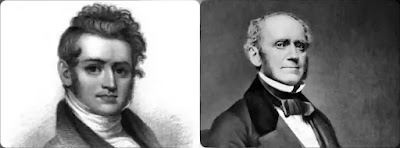Also Read
JOSEPH RODMAN DRAKE
Two friends, who in their early youth styled themselves "The Croakers," were Joseph Rodman Drake (1795-1820) and Fitz-Greene Halleck (1790-1867), "the Damon and Pythias of American poets." Drake was born in New York City in the same year as the English poet, John Keats, in London. Both Drake and Keats studied medicine, and both died of consumption at the age of twenty-five. Halleck was born in Guilford, Connecticut, but moved to New York in early youth, where he became a special accountant for John Jacob Astor. Although Halleck outlived Drake forty-seven years, trade seems to have sterilized Halleck's poetic power in his later life.
The early joint productions of Drake and Halleck were poems known as The Croakers, published in 1819, in the New York Evening Post. This stanza from The Croakers will show the character of the verse and its avowed object:—
"There's fun in everything we meet,The greatest, worst, and best;Existence is a merry treat,And every speech a jest:Be't ours to watch the crowds that passWhere Mirth's gay banner waves;To show fools through a quizzing-glassAnd bastinade the knaves."
This was written by Drake, but he and Halleck together "croaked" the following lines, which show that New York life at the beginning of the nineteenth century had something of the variety of London in the time of Queen Anne, at the beginning of the eighteenth century:—
"The horse that twice a week I rideAt Mother Dawson's eats his fill;My books at Goodrich's abide,My country seat is Weehawk hill;My morning lounge is Eastburn's shop,At Poppleton's I take my lunch,Niblo prepares my mutton chop,And Jennings makes my whiskey punch."
FITZ GREENE HALLECK
Such work indicates not only a diversified circle of readers, who were not subject to the religious and political stress of earlier days, but it also shows a desire to be entertained, which would have been promptly discouraged in Puritan New England. We should not be surprised to find that the literature of this period was swayed by the new demands, that it was planned to entertain as well as to instruct, and that all the writers of this group, with the exception of Bryant, frequently placed the chief emphasis on the power to entertain.
Fortunately instruction often accompanies entertainment, as the following lines from The Croakers show:—
"The man who frets at worldly strifeGrows sallow, sour, and thin;Give us the lad whose happy lifeIs one perpetual grin,He, Midas-like, turns all to gold."
Drake's best poem, which is entirely his own work, is The Culprit Fay, written in 1816 when he was twenty-one years of age. This shows the influence of the English romantic school, and peoples the Hudson River with fairies. Before the appearance of this poem, nothing like these lines could have been found in American verse:—
"The winds are whist, and the owl is still,The bat in the shelvy rock is hid;And naught is heard on the lonely hillBut the cricket's chirp and the answer shrillOf the gauze-winged katydid;And the plaint of the wailing whip-poor-will,Who moans unseen, and ceaseless sings,Ever a note of wail and woe,Till morning spreads her rosy wingsAnd earth and sky in her glances glow."
Although The Culprit Fay shows the influence of Coleridge's Christabel, yet this American poem could not have been written by an English poet. Drake did not sing the praises of the English lark and the nightingale; but chose instead an American bird, the whippoorwill, and a native insect, the katydid, and in writing of them showed the enjoyment of a true poet.
Drake's best known poem, The American Flag, which was signed "Croaker & Co.," because Halleck wrote the last four lines, is a good specimen of rhetorical verse, but lacks the poetic feeling of The Culprit Fay. Fitz-Greene Halleck's best known poem is Marco Bozzaris (1827), an elegy on the death of a Grecian leader, killed in 1823. America's sympathies went out to Greece in her struggles for independence against the Turks. In celebrating the heroic death of Bozzaris, Halleck chose a subject that was naturally fitted to appeal to all whose liberties were threatened. This poem has been honored with a place in almost all American anthologies. Middle-aged people can still remember the frequency with which the poem was declaimed. At one time these lines were perhaps as often heard as any in American verse:—
"Strike—till the last armed foe expires;Strike—for your altars and your fires;Strike—for the green graves of your sires;God—and your native land!"
Fifty years ago the readers of this poem would have been surprised to be told that interest in it would ever wane, but it was fitted to arouse the enthusiasm, not of all time, but of an age,—an age that knew from first-hand experience the meaning of a struggle for hearth fires and freedom. Most critics to-day prefer Halleck's lines On the Death of Joseph Rodman Drake:—
"Green be the turf above thee,Friend of my better days!None knew thee but to love thee,Nor named thee but to praise."
This poem is simpler, less rhetorical, and the vehicle of more genuine feeling than Marco Bozzaris.
The work of Drake and Halleck shows an advance in technique and imaginative power. Their verse, unlike the satires of Freneau and Trumbull, does not use the maiming cudgel, nor is it ponderous like Barlow's Columbiad or Dwight's Conquest of Canaan.
